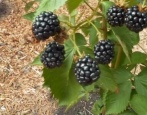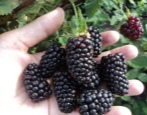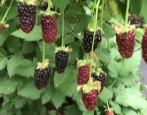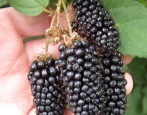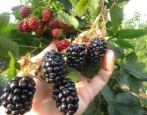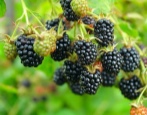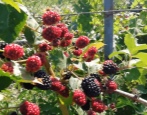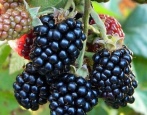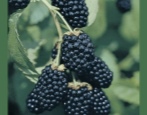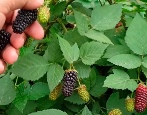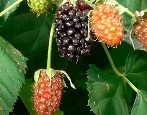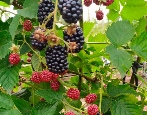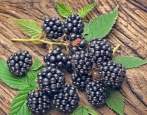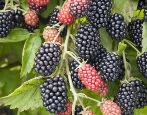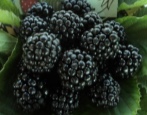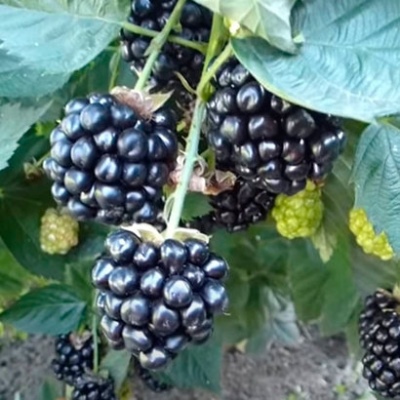
- Authors: USA, University of Arkansas
- Taste: dessert, sweet with subtle sourness
- Scent : pronounced with raspberry notes
- The presence of thorns: Yes
- Berry weight, g: 13-23
- Berry size: very large
- Berry color: black
- Fruiting period: from the end of July or August, within 6 weeks
- Yield: 10 kg per bush, 4-6 t / ha
- Drop off location: draft-proof
Now you can buy any kind of berries that are of excellent quality. Among all blackberry varieties, the Kiova variety stands out. In this article, we will consider the features of the species, yield, taste of berries, agrotechnical requirements and methods of reproduction.
Breeding history of the variety
Blackberry Kiova appeared in America in the state of Arkansas in 1996. To obtain this hybrid, a parental pair was crossed, namely: Arc. 791 and Arc. 1058. The resulting variety was given the name of an Indian tribe. Translated from English, there are two variations of the name: Kiova and Kiowa, both options are correct.
Description of the variety
Kiova blackberry bushes are erect, grow up to 1.5-2 m in length, do not spread on the ground and do not bend. There are large, sharp and very hard thorns throughout the entire branch. Due to the height of the vine, it is necessary to install trellises or other type of fastening of branches. The branches form a large number of shoots, as well as root shoots.
The leaves of the bushes are large, dark green in color, there are sections on the surface, and the edges are finely serrated. Small thorns are present on the back of the leaves.
Blooms are predominantly white, but pink flowers are also found.
Main advantages:
large fruits throughout the entire fruiting;
transportability;
taste qualities.
The disadvantages include:
low frost resistance;
a large number of thorns.
Ripening terms
The ripening period for Kiova blackberries is late. Although flowering begins in May, the fruits ripen only by mid-July. Fruiting occurs within 6 weeks. Much depends on the region of cultivation and the climatic conditions of the season.
Yield
Blackberry Kiova has a high yield. In the warm state of Arkansas, the yield reaches 4-6 tons per hectare.
On the territory of Russia, the indicators are as follows - from 10 kg are collected from one bush.
Berries and their taste
The fruits of the Kiova blackberry are one of the largest among all known varieties. The weight of one berry is on average 13 g, but there are also such large fruits that reach 23 g in weight.
The color of the berries is black, there is a characteristic gloss and bloom. The shape is conical, slightly rounded at the ends. The pulp is juicy and the skin is firm. The taste is sweet and sour, but more sweet. Seeds are medium. The aroma is pronounced, reminiscent of the aroma of wild berries.
Growing features
Blackberries are very unpretentious, but it is worth following some growing rules so that the yield of this variety remains at its best.
It is necessary to plant seedlings in open ground in early spring, because Kiova has poor frost resistance. And during the summer season, the roots of the seedling will take root in the ground, and then it will be easier to transfer frosts.
The place should be chosen south, which is not so strongly blown by the winds, where the sun always shines. Although blackberries love the sun, it is necessary to create partial shade so that the berries do not burn in direct sunlight.
It should be planted on a small mound to avoid constant contact with groundwater.
To oxygenate the root system, it is necessary to periodically loosen the ground around the branches, if the ground is not covered with mulch. It is necessary to loosen between the rows no deeper than 15 cm, about 6 times per season, while removing weeds. Around the vine should be loosened 3 times per season at a depth of no more than 5-8 cm.
Do not plant next to raspberries, roses, rose hips and strawberries, these crops have the same pests.
Site selection and soil preparation
Before planting seedlings, you need to prepare the soil. It is best to dig up the selected area with humus and useful minerals in a month. Give the earth a rest, and only then plant it.
Before planting, it is necessary to check that the seedling has 2 strong shoots, well-developed roots, and more than one bud.
The holes must be dug 50 cm deep and 50 cm wide. The seedling is lowered into the hole, where a small slide of loose earth is prepared, mixed with useful minerals. Gradually, the seedling is filled up, the earth is compacted, and the root collar remains above the ground. The bushes are spilled with a 5 liter bucket of water. The area around the vine should be covered with mulch.
Since blackberry vines are quite large, the distance between the bushes should be at least 1.2-1.5 m, and 2 m should remain between the rows.
Pruning
In the fall, after harvesting, it is worth pruning the vines that bore fruit at the root, as well as those branches that were affected by the disease. Each cut is processed with garden varnish.
In the spring, dry branches and those that have broken are cut off.
Frost resistance and preparation for winter
Frost resistance in blackberries is low, so the plant should be covered for the winter. To do this, you need to remove the vines from the trellises, carefully twist them and put them on the board. A simple cover or agrofibre will not work for this strain due to the very sharp spines. Therefore, you should first lay spruce branches over the vines, and only then cover the bushes.
Reproduction
Reproduction of Kiova blackberries occurs by cuttings and root shoots. It is also possible to propagate by seeds, but in this case, the harvest will come only for 4 years of growth.
For propagation by cuttings, you need to dig out a large and thick root and divide it so that one cutting is 10-15 cm.If you make cuttings in the spring, then you can dig them into the open ground, if in autumn, you can remove the cuttings in a dark, cool place by burying them into wet sand.
During the season, the bushes give a lot of root growth. The healthiest and strongest bush is selected, shoots are separated from it and dug out. When transplanting, the length of the shoot should be 30, maximum 40 cm, the length is measured from the root system. You can transplant the shoots immediately to a new place.


